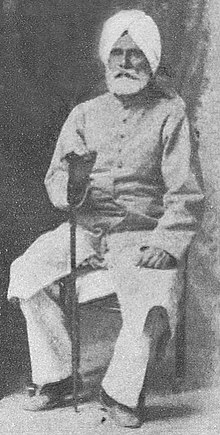Ansari (Panipat)
The Ansaris of Panipat are descended from Khwaja Abdullah Pir of Herat, one of whose descendants settled in Panipat, which was a centre of learning and was already famous for its Mashaikh and Auliya.[1]
Modern Era

The Ansaris of Panipat intermarry with the Pirzadas and Makhdumzadas of Panipat and the Syeds of Barsat and Sonepat.[2][3] The Urdu poet and writer, Altaf Hussain Hali, was born in Panipat as a descendant of the Ansaris.[4] Pakistani nationalist scholars consider his Musaddas-e Hali as an important text leading to the development of Pakistani nationalism.[5] He also wrote the Yadgar-e Ghalib, Hayat-e Saadi, and Hayat-e Javed, which were biographies of Ghalib, Saadi, and Syed Ahmed Khan respectively.[6][7][8]
Mughal Empire
The Ansaris of Panipat held high offices during Muslim rule for several generations.[9]

Lutfullah Khan Sadiq
Shams ud-Daulah Lutfullah Khan Panipati was the wakil of Prince Jahan Shah in Bahadur Shah's time, and deserted him during the War of Succession, gaining the favour of Jahandar Shah.[10] Lutfullah Khan enjoyed the confidence of Farrukhsiyar through flattery, but worked hand in glove with the Sayyid brothers.[11] The Syed brothers considered him to be a source of mischief and deprived him of his rank, and his gardens and mansions were confiscated.[12] As the Mir-i-Saman of Muhammad Shah and later Diwan-i-Khalisa,[13] Lutfullah Khan enjoyed the confidence of the Emperor and enjoyed great influence at court.[14] He succeeded his brother Sher Afgan Khan as governor of Multan.[15] He was later the governor of Shahjahanabad.[16] In spite of having so much wealth, he seized the lands of poorer and weakened people all around Panipat, and had converted them into agricultural lands over an area of 12 km. This was an evidence of the rustic habits and tastes of the noble of this dignified rank. He was known as "Sadiq" or truthful in appreciation of and respect for the fame of his homeplace, Panipat.[17]
Sher Afgan Khan Panipati
Sher Afgan Khan of Panipat was the governor of Multan in the reign of Muhammad Shah.[18] His son was married to the daughter of the Mughal Grand vizier Turrah Baz Khan,[19] another native of Panipat.[20] At court the Mughal Vizier relied on him to support his own faction at court, which was opposed to Khan-i Dauran,[21] an Indian Muslim from Agra who was the Commander-in-Chief of the Mughal empire.[22][23]
Zakariya Khan
Zakariya Khan Bahadur was a descendant of the Ansaris.[24] Originally governor of Jammu, he took part in the expeditions against the Sikhs.[25] Zakariya Khan was the governor of Lahore at the time of Nader Shah's invasion.[26]
Diler Dil Khan
Moin ud-Daulah Diler Dil Khan, originally Khwaja Abdullah, was the son of Khwaja Abdur Razzaq of Panipat. He is mentioned in the Siyar-ul-Mutahkerin as "Dilere Khan, of Puniput, brother of Zakariah Khan Sadik".[27] He had the mansab of 6000,[28] and was the governor of Thatta and Kabul during the reign of Muhammad Shah.[29][30] From 1735 to 1738, he was governor of Kashmir.[31]
Yahya Khan
Yahya Khan, the son of Zakariya Khan, succeeded his father as governor of Lahore.[32]
References
- ISBN 9781526788634.
- ^ Gulshan Lall Chopra (1940). Chiefs and Families of Note in the Punjab-Volume 1. p. 51.
- ISBN 9789693503036.
- ^ Syeda Saiyidain Hameed, 'Introduction', Hali's Musaddas: A Story in Verse of the Ebb and Tide of Islam (New Delhi: HarperCollins, 2003), p. 24.
- ISBN 9780195478112
- ^ Rekhta.
- ^ Hayat-e-Javed by Altaf Hussain Hali, digitized on Academy of the Punjab in North America (APNA) website. Retrieved 15 August 2018.
- ^ Hayat-e-Javed and other e-books by Altaf Hussain Hali first published in the year 1900, digitized on rekhta.org website Retrieved 15 August 2018.
- ISBN 9781349115563.
- ^ Proceedings - Volume 45. Indian History Congress. 1985. p. 311.
- ISBN 9788121508308.
- ^ William Irvine (1971). Later Mughal.
- ISBN 9780210405444.
- ISBN 9780210405987.
- ISBN 9780210405987.
- ^ Indo-iranica: Volume 29. Iran Society (Kolkata, India). 1976.
- ^ Syed H. Askari (1983). Iqbalnama: By an Anonymous Contemporary Writer. p. 96.
- ^ Zahiruddin Malik, Zahir Uddin Malik (1977). The reign of Muhammad Shah, 1719-1748. Asia Publishing House. p. 251.
- ISBN 9788121505499.
- ^ Syed H. Askari (1983). Iqbalnama: by an anonymous contemporary writer. Janaki Prakashan. p. 243.
- ISBN 9780210405987.
- ISBN 9781317845867.
- ^ Historians of Medieval India. Meenakshi Prakashan. 1982. p. 159.
- ISBN 9781349115563.
- ISBN 9780307429339.
- ^ Charles Francis Massy (1890). Chiefs and Families of Note in the Delhi, Jalandhar, Peshawar and Derajat Divisions of the Panjab. Pioneer Press. p. 203.
- ^ Ghulām Ḥusayn Khān Ṭabāṭabāʼī, Ḥājī Muṣṭafā (1924). The Siyar-mutakherin: A History of the Mahomedan Power in India During the Eighteenth Century. p. 109.
- ISBN 9780210223932.
- ^ Charles Francis Massy (1890). Chiefs and Families of Note in the Delhi, Jalandhar, Peshawar and Derajat Divisions of the Panjab. Pioneer Press. p. 203.
- ISBN 9788123023410.
- ^ S.R. Bakshi (1997). Kashmir:History and People. Sarup. p. 132.
- ^ V D. MAHAJAN (2020). Modern Indian History. p. 57.
This article needs additional or more specific categories. (November 2022) |
